
PUMPA - SMART LEARNING
எங்கள் ஆசிரியர்களுடன் 1-ஆன்-1 ஆலோசனை நேரத்தைப் பெறுங்கள். டாப்பர் ஆவதற்கு நாங்கள் பயிற்சி அளிப்போம்
Book Free DemoThe lesson "Kathmandu" is an extract from Vikram Seth's travelogue From Heaven Lake: Travels Through Sinkiang and Tibet (\(1983\)). As seen in the introduction, the book records the journey taken by Seth in reaching his home in New Delhi from a province in China. Kathmandu, the capital and most populous city of Nepal, becomes Seth's final destination before flying back home.
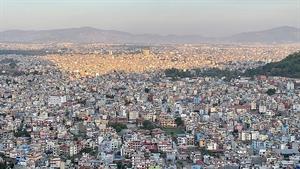
A panoramic view of Kathmandu*
Undoubtedly, the major part of the book focuses on China. Out of the nineteen chapters in the book, the \(1\)st \(17\) describe Seth's journey through China and Tibet. It is only in the \(18\)th Chapter, titled "Into Nepal", that Seth finally crosses the boundary of China. The concluding chapter is from where the lesson "Kathmandu" is taken from. Titled as "Kathmandu; Delhi", the chapter begins with Seth's stay in Kathmandu and concludes with him reaching his destination, Delhi.
One of the distinct features of Seth's travelogue lies not in the description of the monumental places and the ever-popular tourist attractions but rather in the people Vikram Seth meets and befriends. Seth's travel contains several such encounters, which helps shape his understanding of the place and aids in his travel. It is evident from his narrative that he wouldn't have completed his journey hadn't it been for such chance acquaintances. Mr Shah, mentioned in the first paragraph of the lesson, was one such encounter.
Mr Shah was a Nepalese Consul-General in Lhasa, an area in Tibet. When Seth faced a physical obstacle in his journey, Mr Shah suggested him an alternative route.* Mr Shah had spent two years in Bihar, studying international relations at Patna University. Incidentally, Seth had spent about ten years in Patna.** This invariably formed a connection between the two.
As the lesson begins, we see that Seth had reached Kathmandu, found himself a cheap room in the centre of the town, and slept for hours. The phrase "sleep for hours" suggests that Seth was tired. Though Seth had travelled by trucks for most of his journey through China, he had to "walk four days through the hills, then cross the Tibetan border to Nepal on foot".* This explains why he had emphasised on the fact that he slept for hours.
The following day, Seth visits the two temples in Kathmandu that are very sacred to Hindus and Buddhists. The centre of Nepal's history, art, culture, and economy, Kathmandu has a multi-ethnic population, with a Hindu and Buddhist majority. The monuments of Kathmandu City have also been influenced over the centuries by Hindu and Buddhist religious practices. Hence, several of Kathmandu's iconic architecture are its temples. Some of them are – Durbar squares, Hanuman Dhoka, Hindu temples of Pashupatinath and Changunarayan, the Buddha stupas of Swayambu and Boudhanath.
One of the distinct features of Seth's travelogue lies not in the description of the monumental places and the ever-popular tourist attractions but rather in the people Vikram Seth meets and befriends. Seth's travel contains several such encounters, which helps shape his understanding of the place and aids in his travel. It is evident from his narrative that he wouldn't have completed his journey hadn't it been for such chance acquaintances. Mr Shah, mentioned in the first paragraph of the lesson, was one such encounter.
Mr Shah was a Nepalese Consul-General in Lhasa, an area in Tibet. When Seth faced a physical obstacle in his journey, Mr Shah suggested him an alternative route.* Mr Shah had spent two years in Bihar, studying international relations at Patna University. Incidentally, Seth had spent about ten years in Patna.** This invariably formed a connection between the two.
As the lesson begins, we see that Seth had reached Kathmandu, found himself a cheap room in the centre of the town, and slept for hours. The phrase "sleep for hours" suggests that Seth was tired. Though Seth had travelled by trucks for most of his journey through China, he had to "walk four days through the hills, then cross the Tibetan border to Nepal on foot".* This explains why he had emphasised on the fact that he slept for hours.
The following day, Seth visits the two temples in Kathmandu that are very sacred to Hindus and Buddhists. The centre of Nepal's history, art, culture, and economy, Kathmandu has a multi-ethnic population, with a Hindu and Buddhist majority. The monuments of Kathmandu City have also been influenced over the centuries by Hindu and Buddhist religious practices. Hence, several of Kathmandu's iconic architecture are its temples. Some of them are – Durbar squares, Hanuman Dhoka, Hindu temples of Pashupatinath and Changunarayan, the Buddha stupas of Swayambu and Boudhanath.
Coming back to the lesson, Seth explains that he visited the temples with Mr Shah's son and nephew.
One of the two temples that Seth visited was Pashupatinath. The Pashupatinath Temple- dedicated to Lord Pashupati, an incarnation of Lord Shiva- is a famous and sacred Hindu temple complex located on the banks of the Bagmati River. The river is considered holy by both Hindus and Buddhists, and it is worthy to note that several Hindu temples are located on its banks. In its religious significance, it can be likened to the River Ganga in India.
In his visit to the temple, Seth notices a sign outside the temple that reads: "Entrance for the Hindus only". He also observes the crowd and the chaotic atmosphere at the temple. The clutter of "priests, hawkers, devotees, tourists, cows, monkeys, pigeons and dogs" in and around the temple gives way to an "atmosphere of febrile confusion". The phrase “febrile confusion” describes the cluttered and disarrayed scene at the temple.
Speaking about the list, namely, “priests, hawkers, devotees, tourists, cows, monkeys, pigeons and dogs", one could observe how animals were free to roam through the temple grounds. This could be because this avatar of Lord Shiva (Pasupati) is believed to be a protector of animals.
However, it is quite amusing to note how Seth included four sets of humans and non-humans in the list. Also is interesting is the order in which they were positioned.
First come the priests, as they hold one of the most prominent positions in temples. They are treated with reverence, just like the cows. Also, legend says that a cow was integral in the creation of the temple. Once, a cow was seen milking into the barren soil. Amused, the cow's caretaker dug deep at the site and discovered a Shivalinga. This soon led to the formation of the temple.
Second is the hawkers who try to attract the attention of their protentional customers, to the extent that it might seem a bit bothersome. Their presence is both amusing and bothersome, just like the monkeys. Moreover, they are at the temple every day, making them more of residents rather than visitors. Interestingly, so is the case with the monkeys: they live around the temple. Hence, due to their strong presence at the temple, they take up second place.
The third is the devotees. Both devotees and pigeons can be seen everywhere- both inside and outside of the temple. People come flocking and are hard to distinguish as there are just too many of them, same as the pigeons.
Fourth has tourists and dogs. Though they can both roam about as they wish outside the temple, entry to it is usually faced with obstacles. For instance, entry is absolutely denied to the 'tourists who are non-Hindus'. What they face is an invisible barrier. Dogs, on the other hand, might face physical barriers. Monkeys and pigeons, for instance, don't need doors to access the temple. Hence, their entry and exit are not determined by the humans. And, unlike the cows, dogs are not revered, so their presence is hardly anticipated.
Back to the lesson, Seth and his company offer a few flowers to the deity. He then describes the scene at the temple. He observes how the crowd is huge; there are so many worshippers. Those hoping to receive the priest's attention are pushed aside by those rushing to the front. Then, a princess from the Nepalese royal family appears, and everyone bows and makes way.
Speaking of the Nepalese royal family, there is none at the moment. When Seth was visiting Kathmandu, Nepal was under constitutional monarchy-where a country is ruled by a king and queen whose power is limited by a constitution. However, about two decades later, in June \(2001\), the reigning king and queen and several other members of the royal family were killed in a massacre. Less than a decade later, the monarchy was completely abolished, and Nepal became a democratic and secular country. Hence, had Seth visited Nepal a couple of decades later, he might have said things differently, such as, 'a former princess of the now-defunct Nepalese royal house appears'.
Back to the lesson, as Seth walks out, he sees a group of saffron-clad Westerners with a policeman, the former struggling for permission to enter the temple. But the police is unconvinced that they are Hindus.
As Seth walks further, he witnesses a fight between two monkeys. One of them pursues the other, who leaps upon a Shivalinga and races hysterically through the temples and down to the sacred Bagmati river below. Moving farther, he sees a body that is being cremated on the banks of the river. He could also see washerwoman washing clothes, and further down the river, children were bathing.
Seth also observes a basket of flowers and leaves were dropped into the river from a balcony. He calls it "old offerings now wilted" because the practice is almost dying.
A small shrine protrudes halfway from the riverbank's stone platform. It is believed that the shrine would eventually emerge all the way out, and when that happens, the goddess within the shrine will be freed, and the evil period of the Kaliyug will end on earth.
In Hinduism, the Kaliyug is the fourth and worst of the four world eras. Puranic scriptures state that Krishna's departure from the earth led to the beginning of the Kali Yuga. It is believed that Kali Yuga goes for a period of \(432,000\) years (i.e., \(1200\) divine years) and will supposedly end in the year \(428,899\) CE, following the prophesied arrival of Lord Krishna’s tenth and final avatar- Kalki.
In his visit to the temple, Seth notices a sign outside the temple that reads: "Entrance for the Hindus only". He also observes the crowd and the chaotic atmosphere at the temple. The clutter of "priests, hawkers, devotees, tourists, cows, monkeys, pigeons and dogs" in and around the temple gives way to an "atmosphere of febrile confusion". The phrase “febrile confusion” describes the cluttered and disarrayed scene at the temple.
Speaking about the list, namely, “priests, hawkers, devotees, tourists, cows, monkeys, pigeons and dogs", one could observe how animals were free to roam through the temple grounds. This could be because this avatar of Lord Shiva (Pasupati) is believed to be a protector of animals.
However, it is quite amusing to note how Seth included four sets of humans and non-humans in the list. Also is interesting is the order in which they were positioned.
First come the priests, as they hold one of the most prominent positions in temples. They are treated with reverence, just like the cows. Also, legend says that a cow was integral in the creation of the temple. Once, a cow was seen milking into the barren soil. Amused, the cow's caretaker dug deep at the site and discovered a Shivalinga. This soon led to the formation of the temple.
Second is the hawkers who try to attract the attention of their protentional customers, to the extent that it might seem a bit bothersome. Their presence is both amusing and bothersome, just like the monkeys. Moreover, they are at the temple every day, making them more of residents rather than visitors. Interestingly, so is the case with the monkeys: they live around the temple. Hence, due to their strong presence at the temple, they take up second place.
The third is the devotees. Both devotees and pigeons can be seen everywhere- both inside and outside of the temple. People come flocking and are hard to distinguish as there are just too many of them, same as the pigeons.
Fourth has tourists and dogs. Though they can both roam about as they wish outside the temple, entry to it is usually faced with obstacles. For instance, entry is absolutely denied to the 'tourists who are non-Hindus'. What they face is an invisible barrier. Dogs, on the other hand, might face physical barriers. Monkeys and pigeons, for instance, don't need doors to access the temple. Hence, their entry and exit are not determined by the humans. And, unlike the cows, dogs are not revered, so their presence is hardly anticipated.
Back to the lesson, Seth and his company offer a few flowers to the deity. He then describes the scene at the temple. He observes how the crowd is huge; there are so many worshippers. Those hoping to receive the priest's attention are pushed aside by those rushing to the front. Then, a princess from the Nepalese royal family appears, and everyone bows and makes way.
Speaking of the Nepalese royal family, there is none at the moment. When Seth was visiting Kathmandu, Nepal was under constitutional monarchy-where a country is ruled by a king and queen whose power is limited by a constitution. However, about two decades later, in June \(2001\), the reigning king and queen and several other members of the royal family were killed in a massacre. Less than a decade later, the monarchy was completely abolished, and Nepal became a democratic and secular country. Hence, had Seth visited Nepal a couple of decades later, he might have said things differently, such as, 'a former princess of the now-defunct Nepalese royal house appears'.
Back to the lesson, as Seth walks out, he sees a group of saffron-clad Westerners with a policeman, the former struggling for permission to enter the temple. But the police is unconvinced that they are Hindus.
As Seth walks further, he witnesses a fight between two monkeys. One of them pursues the other, who leaps upon a Shivalinga and races hysterically through the temples and down to the sacred Bagmati river below. Moving farther, he sees a body that is being cremated on the banks of the river. He could also see washerwoman washing clothes, and further down the river, children were bathing.
Seth also observes a basket of flowers and leaves were dropped into the river from a balcony. He calls it "old offerings now wilted" because the practice is almost dying.
A small shrine protrudes halfway from the riverbank's stone platform. It is believed that the shrine would eventually emerge all the way out, and when that happens, the goddess within the shrine will be freed, and the evil period of the Kaliyug will end on earth.
In Hinduism, the Kaliyug is the fourth and worst of the four world eras. Puranic scriptures state that Krishna's departure from the earth led to the beginning of the Kali Yuga. It is believed that Kali Yuga goes for a period of \(432,000\) years (i.e., \(1200\) divine years) and will supposedly end in the year \(428,899\) CE, following the prophesied arrival of Lord Krishna’s tenth and final avatar- Kalki.
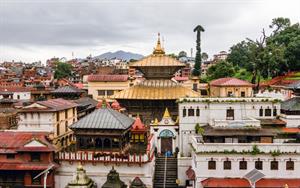
Pasupathinath Temple*
Following his visit to Pasupatinath temple, Seth drops by the Baudhnath stupa. Baudhnath stupa is considered one of the holiest Buddhist shrines in Nepal, holding an important place of pilgrimage and meditation for Tibetan Buddhists & local Nepalis. Stupa, a mound-like or hemispherical spiritual/religious structure, is also one of Baudhnath's striking features. Its massive dome makes it one of the largest in the world.
However, Seth is rather impressed by the serene atmosphere at the shrine. He couldn't help but compare it with the "atmosphere of febrile confusion" found at Pasupatinath temple. 'There is a sense of stillness at Baudhinath stupa', claims Seth.
However, Seth is rather impressed by the serene atmosphere at the shrine. He couldn't help but compare it with the "atmosphere of febrile confusion" found at Pasupatinath temple. 'There is a sense of stillness at Baudhinath stupa', claims Seth.
Seth notes that a road encircles the shrine, and to more specific, "its immense white dome". The line "its immense white dome is ringed by a road" can be further analysed. Here, the word dome stands for the entire temple. By saying that a road encircles the dome, it indeed means that a road encircles the temple. "Dome", here, is an example of synecdoche-- 'a figure of speech where a part of something is used to refer to the whole'.
Seth also observes that small shops are put up along the perimeter, many of which are run by Tibetan immigrants who sell felt bags, Tibetan prints, and silver jewellery.
Again, Seth notes that there are no crowds at the Stupa. Seth is amazed by its tranquillity. Seth notes that the place is 'a haven of quietness', referring to how serene and peaceful the place is, despite being in the midst of the bustling streets.
Seth also observes that small shops are put up along the perimeter, many of which are run by Tibetan immigrants who sell felt bags, Tibetan prints, and silver jewellery.
Again, Seth notes that there are no crowds at the Stupa. Seth is amazed by its tranquillity. Seth notes that the place is 'a haven of quietness', referring to how serene and peaceful the place is, despite being in the midst of the bustling streets.
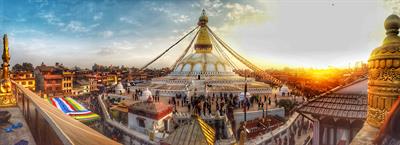
Baudhnath stupa*
In paragraph \(4\), Seth describes what he had seen and experienced in Kathmandu. He calls Kathmandu a 'vivid, mercenary, and religious' city. It is interesting to note how adjectives such as "mercenary" and "religious" were put together to suggest that religion is commercialised.
He also observes how Kathmandu had little temples to big flower-adorned deities lining the narrowest and busiest streets. There were a lot of hawkers, sellers, and shops lines up on the streets. There were fruit vendors, flute sellers, postcard hawkers, shops selling Western cosmetics, film rolls, chocolate, copper cookware, and Nepalese antiquities.
Kathmandu, as Seth remarks, is also filled with all kinds of sounds. From film songs that blast out from radios, car horns, bicycle bells, and to the sellers who call out their wares, the city's sounds come alive.
He also observes how Kathmandu had little temples to big flower-adorned deities lining the narrowest and busiest streets. There were a lot of hawkers, sellers, and shops lines up on the streets. There were fruit vendors, flute sellers, postcard hawkers, shops selling Western cosmetics, film rolls, chocolate, copper cookware, and Nepalese antiquities.
Kathmandu, as Seth remarks, is also filled with all kinds of sounds. From film songs that blast out from radios, car horns, bicycle bells, and to the sellers who call out their wares, the city's sounds come alive.
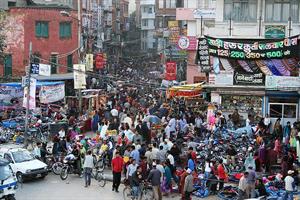
A busy street in Kathmandu*
In the middle of the vibrant human activity, Seth notices that stray cows are found at the centre as if they were peering questioningly at passing motorcycles.
Later, Seth indulges himself mindlessly. He buys a bar of marzipan (a sweet made of almond flour), and an ear of grilled corn rubbed with salt, chilli powder, and lemon. Seth also buys a couple of love story comics and a Reader’s Digest (a popular family magazine in English). He ends his mini shopping with Coca-Cola and a not-so-good orange drink, and he feels considerably better as a result.
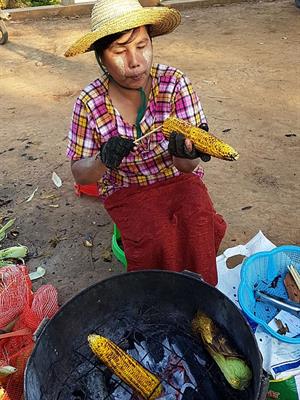
A woman roasting corn-on-the-cob in a brazier**
As we had seen before, Kathmandu had been Seth's final destination before going back to his home. In this paragraph, Seth reveals his anxiety to get back to his hometown as quickly as possible.
He is looking at the possible options for returning home. If he is up to more adventure, he can travel to Patna by bus and train, sail up the Ganges past Benaras to Allahabad, then up the Yamuna past Agra, and finally to Delhi. Or, he could simply get an air ticket.
Having had a long journey that began in China, he is too tired and homesick. Understandably, Seth wants to get home as fast and easy as possible. It was the last day of August, and he had spent over a month on his journey through China and Tibet (having begun his journey in July).
He is looking at the possible options for returning home. If he is up to more adventure, he can travel to Patna by bus and train, sail up the Ganges past Benaras to Allahabad, then up the Yamuna past Agra, and finally to Delhi. Or, he could simply get an air ticket.
Having had a long journey that began in China, he is too tired and homesick. Understandably, Seth wants to get home as fast and easy as possible. It was the last day of August, and he had spent over a month on his journey through China and Tibet (having begun his journey in July).
Seth tells himself to go home directly. No more detours and adventures. He then goes into a Nepal Airlines office and purchases a flight ticket for the following day's journey.
Later in the day, Seth observes a flute seller standing in the corner of the square near the hotel.
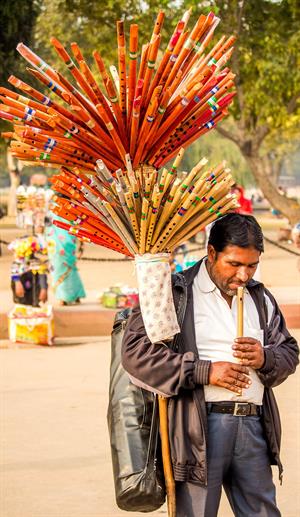
A flute seller with protruding flutes
The seller was holding a pole from which about fifty or sixty bansuris (a bamboo flute from the Indian subcontinent) were sticking out in all directions. Seth comments that the protruding flutes looked like porcupine quills.
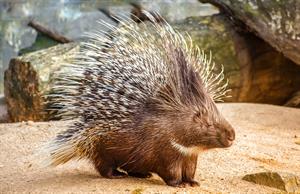
A porcupine with its quills
The seller had cross-flutes and recorders, both made of bamboo, tucked into his pole.
A cross-flute, also known as transverse flute, is held horizontally and is side-blown. A cross-flute is often associated with Lord Krishna in India.
A cross-flute, also known as transverse flute, is held horizontally and is side-blown. A cross-flute is often associated with Lord Krishna in India.
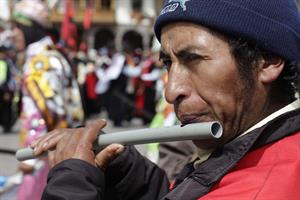
A man can be seen playing a cross-flute
Recorder, on the other hand, is a flute that is held vertically and is blown downwards. Moreover, a recorder's mouthpiece resembles a whistle.

A girl plays a recorder
Back to the lesson, Seth notes that the seller was in the habit of doing something: he places the pole on the ground from time to time, selects a flute, and plays for a few minutes. He probably does that to attract customers, to let them see what they could do with a small flute.
As the seller plays his notes, the music slowly rises above the noise of the traffic and the cries of the hawkers. He plays quietly, meditatively, and without excessive display. Unlike the rest of the hawkers, he doesn't call out his products loudly. He doesn't have to, for he makes the presence of his wares known through his music.
The flute seller doesn't seem too keen on selling or making profits. He occasionally sells a flute or two, but in an oddly casual manner, as if it were unrelated to his business.
The seller also takes a break from playing occasionally. And he would indulge in a conversation with his neighbouring seller, the fruit vendor. Seth believed that this had been his routine for years.
As the seller plays his notes, the music slowly rises above the noise of the traffic and the cries of the hawkers. He plays quietly, meditatively, and without excessive display. Unlike the rest of the hawkers, he doesn't call out his products loudly. He doesn't have to, for he makes the presence of his wares known through his music.
The flute seller doesn't seem too keen on selling or making profits. He occasionally sells a flute or two, but in an oddly casual manner, as if it were unrelated to his business.
The seller also takes a break from playing occasionally. And he would indulge in a conversation with his neighbouring seller, the fruit vendor. Seth believed that this had been his routine for years.
Seth finds it difficult to pull himself away from the music. He explains how flute music had always had such an effect on him. He also calls it is both the most universal and most particular of sounds.
Flutes have been in use since the ancient times. Archeological studies tells us that they are the earliest known musical instruments in the world. Moreover, they are found and practised all over the world. Seth cites a few types of flutes that are used around the continents.
The reed neh (also spelled as 'ney'), the recorder, the Japanese shakuhachi, the deep bansuri of Hindustani classical music, the clear or breathy flutes of South America, the high-pitched Chinese flutes demonstrates how flute transcends space and culture. Though they are universal, they are also equally distinct. Hence, Seth calls it "the most universal and most particular of sounds". Moreover, each type of flute is distinct for its placement of the holes, fingering, and the musical range.
The music of a flute brings an entire culture along. It is rich in history and tradition. Through the line 'flute weaves its own associations', Seth explains how the music from a flute brings the culture, tradition, and history that it is associated with. On the other hand, as Seth explains, music of a flute draws one into the universality of humanity. Despite the differences in culture, language, race, sex, gender, or age, human beings are universal. The basic needs of a human, such as food, water, and oxygen, remains the same. Similarly, flutes are given life through the breath of its player. They are also closest to the human voice, both physically and figuratively. Flutes and voice have a mutual friend: mouth. In that way, they are physically closer to the voice of a human. With other musical instruments, the player can accompany their music with their vocals, but for a flautist, flutes are their vocals. Moreover, flutes are closest to the human voice in its "phrases and sentences" (in music theory, a "phrase" and "sentence" are units of musical metres.)
Seth concludes the paragraph by reminding us that both a flute and human voice draw their power from breath. And like ones voice, it too must halt and breathe before continuing.
Seth is surprised to see himself musing over a piece of flute music. He is amazed by the fact that a few familiar phrases on the bansuri had such an impact on him.
He calls the music familiar because a bansuri is not new to him. In fact, a bansuri features in most Indian classical or contemporary music. However, what astonishes him the most is the fact that he perceives the music differently.
Seth states that he had never noticed those details before. Moreover, he adds that he had never invested time or effort into deciphering flute music, nor had he associated it with the various meanings and significance he was doing now. He had never felt like that before, never during any of the previous occasions when he had returned home after a long absence abroad.
The only thing that is different now and then was the journey he had undertaken. Though everything remained the same, his long journey from China to his home in India transformed him, enabling him to look at things differently.
A flute seller's playing his bansuri*
Reference:
PC: A panoramic view of Kathmandu: Locus Chand, CC BY-SA 4.0
PC Pasupathinath Temple: Bijay Chaurasia, CC BY-SA 4.0
PC Baudhnath stupa: Bijay chaurasia, CC BY-SA 4.0 , via Wikimedia Commons
PC: A busy street in Kathmandu: Pavel Novak, CC BY-SA 2.5 <https://creativecommons.org/licenses/by-sa/2.5>, via Wikimedia Commons
PC: Roasting corn on the cob in a brazier: Etan J. Tal, CC BY-SA 4.0 <https://creativecommons.org/licenses/by-sa/4.0>, via Wikimedia Commons
VC: A flute seller's playing his bansuri: https://www.youtube.com/watch?v=aRP9PrWOz4E&t=3s